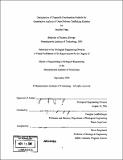| dc.contributor.advisor | Douglas Lauffenburger. | en_US |
| dc.contributor.author | Fang, Jennifer, M. Eng. Massachusetts Institute of Technology | en_US |
| dc.contributor.other | Massachusetts Institute of Technology. Biological Engineering Division. | en_US |
| dc.date.accessioned | 2007-08-03T18:18:47Z | |
| dc.date.available | 2007-08-03T18:18:47Z | |
| dc.date.issued | 2006 | en_US |
| dc.identifier.uri | http://hdl.handle.net/1721.1/38244 | |
| dc.description | Thesis (M. Eng.)--Massachusetts Institute of Technology, Biological Engineering Division, 2006. | en_US |
| dc.description | "September 2006." | en_US |
| dc.description | Includes bibliographical references (p. 141-147). | en_US |
| dc.description.abstract | Nonviral vector research and development has been stunted by a lack of knowledge and understanding of how vectors are trafficked within the cell. Research currently involves mass screenings of different combinations of vector components without a true understanding of how each component interacts with the target cell. Few tools are currently available for scientists to quantitatively examine these vector-to-cell interactions or determine the rate limiting steps within the gene delivery pathway. Thus, researchers cannot fully optimize the vector design to reach maximal delivery efficiency. This project seeks to address this issue by modifying a density gradient electrophoresis (DGE) device originally developed on Mel Juso cells to segregate primary rat hepatocyte lysate into nuclear, early endosomal, late endosomal/lysosomal, and cytoplasmic fractions. We found that according to the Horseradish Peroxidase assay, late endosomes and lysosomes consistently localize to fractions 11-13 and early endosomes in fractions 18 to 21. There was minimal labeling in fractions 14 through 17 demonstrating that separation of the organelles was achieved. With this higher resolution fractionation, movement through the endosomal pathway can be studied in greater detail. | en_US |
| dc.description.abstract | (cont.) The rates with which each vector moves from outside of the cell into the early endosome, to the late endosome, to the cytoplasm and into the nucleus can be quantified. The steps affected by specific modifications to the vector design and the vector properties most important for delivery efficiency can be identified. As vectors are sorted differently in different cell types, this DGE device will allow researchers to gain insight of the cell-specific sorting mechanisms. Ultimately, DGE can aid design of vectors that reach delivery efficiencies comparable to viruses and tailor the vectors to the tissue of interest. | en_US |
| dc.description.statementofresponsibility | by Jennifer Fang. | en_US |
| dc.format.extent | 147 p. | en_US |
| dc.language.iso | eng | en_US |
| dc.publisher | Massachusetts Institute of Technology | en_US |
| dc.rights | MIT theses may be protected by copyright. Please reuse MIT thesis content according to the MIT Libraries Permissions Policy, which is available through the URL provided. | en_US |
| dc.rights.uri | http://dspace.mit.edu/handle/1721.1/7582 | |
| dc.subject | Biological Engineering Division. | en_US |
| dc.title | Optimization of organelle fractionation methods for quantitative analysis of gene delivery trafficking kinetics | en_US |
| dc.type | Thesis | en_US |
| dc.description.degree | M.Eng. | en_US |
| dc.contributor.department | Massachusetts Institute of Technology. Department of Biological Engineering | |
| dc.identifier.oclc | 146477581 | en_US |
